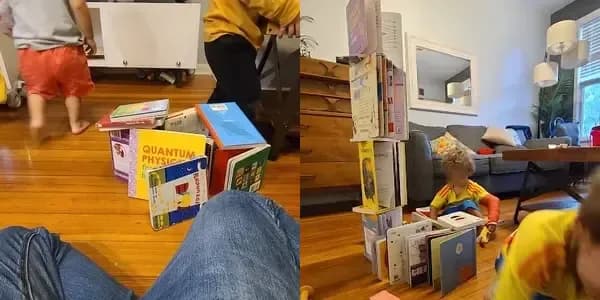Children defy expected uses of life’s building blocks
I have twins. They are at that age where they get just a bit about how the world works, but every detail is still a surprise. Books fall because of gravity? Amazing. Planes don’t fall as long as they go quick? Stupendous. Spiders and flies are in fact completely different animals? Incredible.
I’ve found that there is some magic to their whimsical wonder and surprise. As in, usable magic. Just the other day they were looking for something to do and decided to build a library (because why not?). We are temporarily in a home away from home, with no blocks for them to build with. But what we do have is books (we got a ton from a free bookstore a couple of blocks away). They grabbed their pile of books with determined frowns. I was fully expecting them to mimic a bookshelf somehow. But instead… they built a library (with no books in it). And a fire station and a house. And a tower too.

This got me thinking… how else do they subvert everyday expectations through sheer ignorance of what’s expected? They role-play as Spider-Man, one being Peter Parker (permanently, he doesn’t really answer to Franco anymore), and the other being Miles Morales. But Luca wants to be Peter every once in a while. So, what to do? Well, we can have 2 Peters (because why not?)
And all of this experimentation comes with 0 expectation of utility, gain or monetization. It is done out of pure curiosity. Perhaps this may be the most powerful factor of all: if curiosity is the main driver, then the “correct way” is worthless, in fact any other way is valid and maybe even better.
Children seldom limit themselves by impossibility.
After proof-reading, this reminded me of “We the Possibility” by Mitchell Weiss, a great book on how to innovate in environments where innovation itself is thought an impossibility.
They simply adapt their thinking to the circumstances in front of them, using whatever tools are immediately available.
Technology can be indistinguishable from magic
The world we live in is full of technology so advanced, that it is impossible to be knowledgeable to all the details behind it. In practical terms, it really is magic (as in, it ‘just works’ through some unknown mechanism).
People in the tech bubble are often wondering how this magic comes about, and most likely even began their careers through that same curiosity that drives children: The drive to try and understand the world through the lens of the uninitiated. Through that path lies the learning of how to use some subset of technology.
Once you begin delving into how tech works, you quickly realize it is truly block on top of block on top of block. Some of the blocks down at the base of modern software are extremely arcane to all but a miniscule handful of humans in the world (Assembly Compilers? Microprocessor Design? Div centering?).
Most programmers (myself included) limit themselves to knowing the same few ‘spells’ in the lore: Common programming languages (Python? Typescript? Go if you are the adventurous type), common frameworks (React-based) and if you specialize deep enough you’ll use a few harder-to-understand spells depending on your road of choice. Data Science has its grimoire, DevOps its own, animation or game development or robotics or any other path comes with its own set of ever-deepening knowledge.
As you gain understanding, the ‘magical’ aspect of new things may go away. This discussion on HN touches deeply on the subject of people both losing and gaining back their sense of magic in tech.

Most of us have no idea or at best an extremely faint idea of how the building blocks behind Python or React or Pandas or the Internet or Satellites or whatever-else-comes-to-mind works. We just trust they do just as we trust that a car’s engine will work, water will flow when we turn the tap or that mom’s cooking will taste the same as we were kids even 30 years later. No need to know the details of how.
Wonder at technology blocks
Kids, if they were able to grasp the little blocks making up tech, would violently knock them down and build them back up in unnatural (but unexpected ways). And they would learn how some of those small blocks work along the way.
I think we should marvel and wonder at how our every-day tech works and every now and then try to understand what is under the hood. No different than disassembling our old home telephone, just with software instead of wires and plastic. How, exactly, does React or Ruby or DNS or HTTPS or FastAPI work? What are the spells behind our spells?
Once we get there, can we reconfigure those new magicks -cantrips!- into new forms?
Another less famous but not less important example is PySkyWifi, which managed to send data from a plane to a computer using the free in-flight WiFi and creative use of a form.
- NodeJS reimagined what could be done with Javascript. Why synchronous and frontend only?
- The Gameboy reimagined gaming. Why should it be tied to a TV?
- SpaceX reimagined rockets. Why should you discard your rocket?
Child-like wonder leads you to invention, novelty, creativity.
Hanging out with my boys has, among other things, taught me how to exercise my lateral thinking to the extreme. One of them broke his arm. He saw his cast not as a handicap but as a bludgeoning weapon (because why not?). A piece of wood can be a toy man, a writing instrument or a lethal projectile, or all at the same time as I’ve learnt. To them, all these little concepts are as malleable as they need to be for the activity at hand.
Using that same technique we can reach new innovations and true novelty. Maybe child-like lateral thinking is the engine of true invention that we need to crack a creative rut we may be in.
One small closing advice (for myself, I think). It’s probably better to exercise this creative muscle as a child does: With no intrinsic reward to the process other than amusement and curiosity fulfilled. As it’s painfully obvious to anyone that has looked and found a good idea, they come to you not when you are looking but when you stop searching completely, cooking or bathing or sleeping. I think exercising lateral thinking muscle sans-objective will handsomely increase the rate at which aha-moments come about.